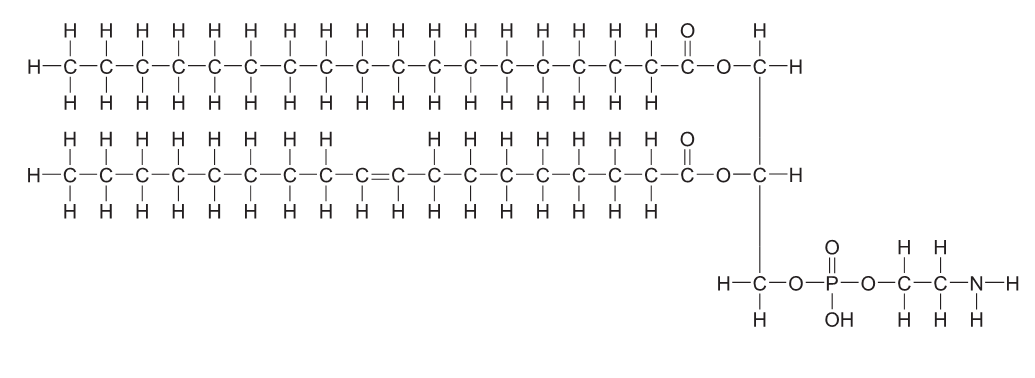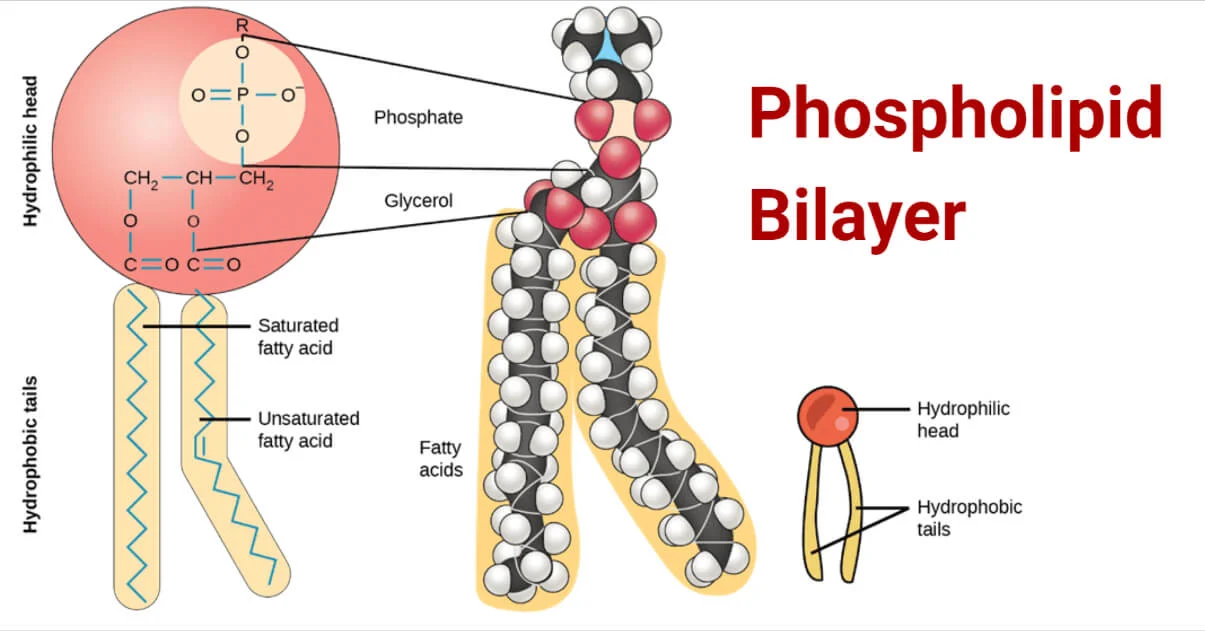A diagram of a membrane

[Source: © International Baccalaureate Organization 2017]
In the diagram, which part of the membrane structure does the molecule below form?

▶️Answer/Explanation
Markscheme
A

The polar head of a lipid bilayer is the hydrophilic region of a phospholipid molecule that forms the outer surface of the membrane. It contains a phosphate group that is electrically charged and can interact with water molecules. The polar head is attached to a glycerol backbone that links it to the nonpolar tail of the phospholipid. The tail is composed of two fatty acid chains that are hydrophobic and face inward in the bilayer. The polar head and the nonpolar tail give the phospholipid a amphiphilic property, meaning it has both water-loving and water-hating parts. This allows the phospholipids to form a stable barrier between the cell and its environment.
The cell membrane model proposed by Davson–Danielli was a phospholipid bilayer sandwiched between two layers of globular protein. Which evidence led to the acceptance of the Singer–Nicolson model?
A. The orientation of the hydrophilic phospholipid heads towards the proteins
B. The formation of a hydrophobic region on the surface of the membrane
C. The placement of integral and peripheral proteins in the membrane
D. The interactions due to amphipathic properties of phospholipids
▶️Answer/Explanation
C

The Singer-Nicolson model of lipid bilayer was proposed in 1972 by S.J. Singer and G.L. Nicolson to explain the structure and function of cell membranes. They suggested that membranes are dynamic structures composed of proteins and phospholipids, in which the phospholipid bilayer is a fluid matrix for proteins.
Some of the evidence that supported their model were.
Labeling experiments, x-ray diffraction, and calorimetry showed that integral membrane proteins diffuse at rates affected by the viscosity of the lipid bilayer, and that the molecules within the cell membrane are dynamic rather than static.
– Microscopy and thermodynamic data did not support previous models that had proteins present as sheets neighboring a lipid layer, or as repeating, regular units of protein and lipid.
– The Frye-Edidin experiment showed that when two cells are fused, the proteins of both diffuse around the membrane and mingle rather than being locked to their area of the membrane.
– Fluorescence microscopy and structural biology have validated the fluid mosaic nature of cell membranes and their involvement in various cellular processes.
A number of different proteins are involved in nerve function. Which of the following does not require a membrane protein?
A. Active transport of sodium
B. Diffusion of K+ into the cell
C. Diffusion of the neurotransmitter across the synapse
D. Binding of the neurotransmitter to the post-synaptic membrane
▶️Answer/Explanation
Markscheme
C

Diffusion of the neurotransmitter across the synapse is a process that involves the release of chemical messengers from the presynaptic neuron and their binding to receptors on the postsynaptic neuron. The neurotransmitter molecules then diffuse across the synaptic cleft, a fluid-filled space that separates the two neurons. This diffusion does not require the membrane protein because it is a passive process that depends on the concentration gradient of the neurotransmitter. The higher the concentration of the neurotransmitter in the presynaptic neuron, the faster it will diffuse across the synaptic cleft. The diffusion stops when the neurotransmitter binds to the receptor or is removed from the synaptic cleft by reuptake or degradation.
Question
More than 90% of cellular cholesterol is located in the cell’s plasma membrane. What is the
main role of cholesterol in the plasma membranes of mammalian cells?
A. To regulate membrane fluidity
B. To increase membrane solubility
C. To increase membrane permeability
D. To regulate membrane temperature
▶️Answer/Explanation
Ans: A
A. The main role of cholesterol in the plasma membranes of mammalian cells is to regulate membrane fluidity.
Cholesterol is a type of lipid that is found in the plasma membranes of mammalian cells. It plays an important role in regulating the fluidity of the membrane.
At low temperatures, cholesterol acts as a buffer, preventing the membrane from becoming too rigid and maintaining its fluidity. At high temperatures, cholesterol helps to stabilize the membrane and prevent it from becoming too fluid.
Therefore, cholesterol is important for maintaining the structural integrity of the membrane and for ensuring that it functions properly. Other functions of cholesterol in the plasma membrane include modulating the activity of membrane proteins and influencing the formation of lipid rafts, which are specialized regions of the membrane that are involved in cell signaling.
The statement that best describes the main role of cholesterol in the plasma membranes of mammalian cells is that it regulates membrane fluidity.